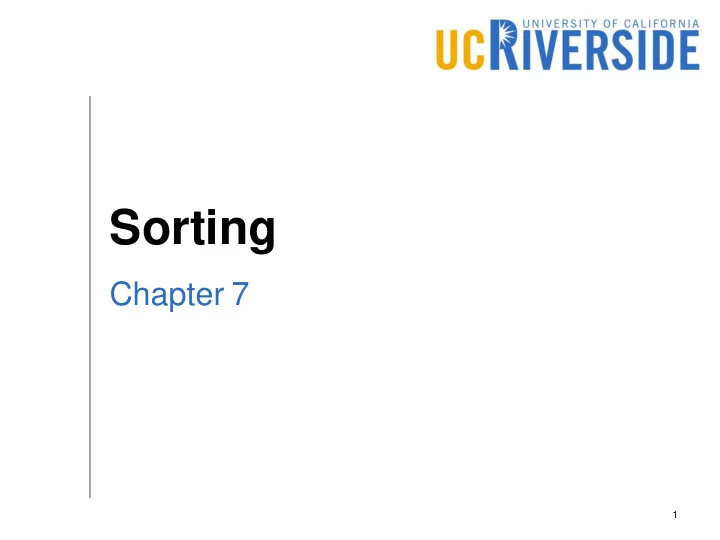

Sorting Chapter 7 1
Quick Sort One of the most popular fast sorting algorithms Quick sort overcomes the drawback of merge sort of creating an additional array Generally, quick sort is the most efficient algorithm for large arrays 2
Quick Sort Pick any element in the array (call it the pivot) Place the pivot in its correct position in the array Move all smaller elements to the left Move all bigger elements to the right Sort the left and right sides recursively 3
Quick Sort Example 8 10 5 1 3 20 13 7 2 12 4
Quick Sort Example Select the pivot 8 10 5 1 3 20 13 7 2 12 pivot 5
Quick Sort Example Partition the array 8 10 5 1 3 20 13 7 2 12 pivot 6
Quick Sort Example Recursively sort both sides 5 1 3 7 2 8 10 20 13 12 pivot Quick sort Quick sort 7
Selecting the Pivot What would be a good pivot? What would be a bad pivot? What is the ideal pivot? Naïve selection: First element in the list A good selection: A random element A better selection: Median-of-three 8
Median-of-three 8 10 5 1 3 20 13 7 2 12 pivot 46 15 10 6 9 15 2 5 18 12 pivot 15 48 29 18 1 19 33 23 27 41 pivot 9
Partitioning The key idea about Quick Sort is to make an in-place partitioning Take the pivot out of the way Move bigger elements to the right Move smaller elements to the left Replace the pivot at its place 10
Partitioning Example 8 10 5 1 11 20 13 7 22 12 pivot 11
Partitioning Example 8 10 15 1 12 20 13 7 22 11 pivot 12
Partitioning Example 8 10 15 1 12 20 13 7 22 11 i j pivot 13
Partitioning Example 8 10 15 1 12 20 13 7 22 11 j pivot i 14
Partitioning Example 8 10 15 1 12 20 13 7 22 11 j pivot i 15
Partitioning Example 8 10 15 1 12 20 13 7 22 11 j pivot i 16
Partitioning Example 8 10 15 1 12 20 13 7 22 11 i pivot j 17
Partitioning Example 8 10 15 1 12 20 13 7 22 11 i pivot j 18
Partitioning Example 8 10 15 1 12 20 13 7 22 11 i j pivot 19
Partitioning Example 8 10 7 1 12 20 13 15 22 11 i j pivot 20
Partitioning Example 8 10 7 1 12 20 13 15 22 11 i j pivot 21
Partitioning Example 8 10 7 1 12 20 13 15 22 11 j pivot i 22
Partitioning Example 8 10 7 1 12 20 13 15 22 11 j pivot i 23
Partitioning Example 8 10 7 1 12 20 13 15 22 11 i pivot j 24
Partitioning Example 8 10 7 1 12 20 13 15 22 11 i pivot j 25
Partitioning Example 8 10 7 1 12 20 13 15 22 11 i j pivot 26
Partitioning Example 8 10 7 1 12 20 13 15 22 11 i pivot j 27
Partitioning Example 8 10 7 1 12 20 13 15 22 11 j i pivot i and j are reversed! 28
Partitioning Example 8 10 7 1 11 20 13 15 22 12 j i pivot 29
Analysis of Quick Sort Cost of the partitioning step O(n): One scan over the list Worst case The sizes of the two sublists are 0 and n-1 O(n 2 ) Best case The sizes of the two sublists are almost equal O(n log n) Average case None of the lists is excessively large or small O(n log n) 30
Comparison of Sorting Algorithms Algorithm Worst- Best- Average Stable* In-place case case Insertion Selection Bubble Shell Heap Merge Quick *A sorting algorithm is said to be stable if equal items remain in the same order after sorting 31
Comparison of Sorting Algorithms Algorithm Worst- Best- Average Stable* In-place case case O(n 2 ) O(n 2 ) Insertion O(n) O(n 2 ) O(n 2 ) O(n 2 ) Selection O(n 2 ) O(n 2 ) Bubble O(n) O(n 3/2 ) Shell Heap O(n log n) O(n log n) O(n log n) Merge O(n log n) O(n log n) O(n log n) O(n 2 )** Quick O(n log n) O(n log n) *A sorting algorithm is said to be stable if equal items remain in the same order after sorting ** Can be reduced to O(n log n) with a smart pivot selection algorithm 32
Lower Bound for Sorting Can we create a sorting algorithm with an asymptotic running time that is lower than O(n log n) in the worst case? Assumptions Array elements can be in any order Only comparisons are used to sort elements 33
Decision Tree (Execution Tree) Initial state Comparison Number of comparisons Execution terminated 34
Worst-case Deepest part of the tree Number of leaf nodes Equal to total number of permutations n! Height of the tree log(n!) log 𝑜! = Ω 𝑜 log 𝑜 𝑜 log 𝑜 is a lower bound for any comparison- based sorting algorithm 35
Recommend
More recommend